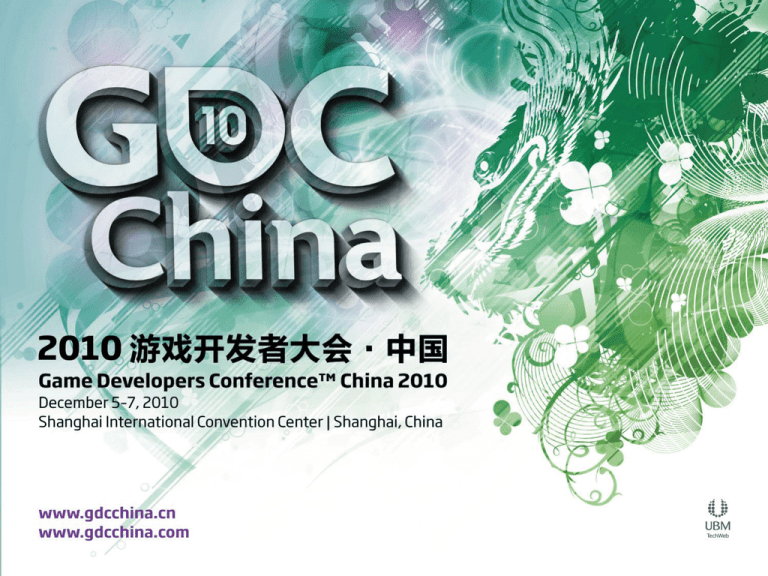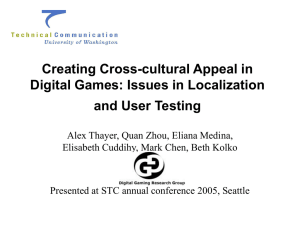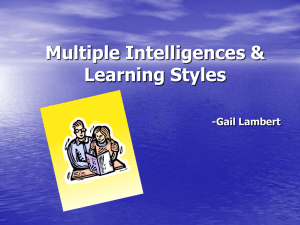
Smart Globalization Techniques for
Maximizing the Cultural Appeal of
Game Content
Kate Edwards
Principal Consultant & Founder, Englobe Inc.
Chair & Founder, IGDA Game Localization SIG
www.englobe.com
kate@englobe.com
6 December, 2010
Content:
Information created for perpetuation and
dissemination; in games, anything a player
will see, hear or read.
Context:
The circumstances or events that form a
unique environment in space and time,
within which information is created and
managed.
Culture:
The accumulated, managed content of a
specific context. Think of a “culture” as
“content assets”.
Content carries culture.
Reflects the culture in which it’s created.
Evokes a reaction from cultures to which
it’s distributed.
Critical globalization issue!
Cultural expectations equate to an
in/compatibility of content assets.
Origin
Culture
Target
Culture
Challenge: Making the correct
assumptions about expectations;
i.e., culturalization.
Origin
Culture
Target
Culture
The Game Industry’s Future is Global
Localization = ~50% of total industry revenue.
PricewaterhouseCooper’s projections show
industry growth at 10.5% annually through 2014
(worth US$84B - from US$41.9B in ‘07).
Localization typically contributes from ~33% to
70% of total revenue per company.
Designing games for a global audience is critical
for long-term growth.
Localization
Culturalization
Regional flavors:
Hokkaido: yubari melon and baked corn
o Tokyo: Sweet potato and soybean.
o
Culturalization –
Culturalization +
Zone of Globalization Risk
Game
Worlds
(Very) Real
Worldviews
All gamers import The
theircollective assumptions,
The aggregation of
collectively-created culture into the experience
beliefs and expectations of
content spaces (games, and begin to contrast local individuals and/or
MMOs, social networks, against expectations.
cultural groups.
mobile, etc.)
External manipulation of a culture’s
content assets is intensely defended.
Culturalization often means knowing
what to avoid in order to know what
to improve.
Key Culturalization Strategies:
1.
2.
3.
4.
Avoid primary culturalization challenges
Observe context proximity & autonomy
Perform smart, surgical decisions
Anticipate local expectations
Key Culturalization Strategies:
1.
2.
3.
4.
Avoid primary culturalization challenges
Observe context proximity & autonomy
Perform smart, surgical decisions
Anticipate local expectations
Primary Culturalization Challenges
History: Past and Present
Religion: Sacred vs. Secular
Ethnicity: Inclusion vs. Exclusion
Politics: Geopolitical Perceptions
Culture: Cultural Friction
History: Past and Present
Historical memory is persistent.
Korea: Age of Empires (1997)
United States: Six Days in Fallujah (2009)
United States: JFK Reloaded (2004)
Religion: Sacred vs. Secular
Cultures maintain expectations that may
originate in religious beliefs.
India: Fallout 3 (2008) & Fallout: New Vegas (2010)
United Kingdom: Resistance: Fall of Man (2007)
Islam: Kakuto Chojin (2002) & Little Big Planet (2007)
Ethnicity: Inclusion vs. Exclusion
Perceived inequitable treatment of a specific
culture, ethnicity and/or nationality.
United States: Resident Evil 5 (2009)
Polynesia: Pocket God (2009)
Poland: Microsoft IT Tools Marketing (2009)
Politics: Geopolitical Perceptions
Government reinforcement of national
sovereignty and territorial integrity.
Korea: Ghost Recon 2 (2004), Mercenaries (2005) &
Homefront (2010)
China: Ninja Gaiden (2004)
Country/Region
Taiwan
India: Jammu and Kashmir
Some governments require
by law that maps conform
to their local worldview.
U.S./Global Locale
India Locale
Culture: Cultural Friction
General tension or inaccuracies between cultures
and nationalities on a wide variety of issues.
Singapore: Just Cause 2 (2010)
Players disliked Bolo
Santosi’s poor accent; a
mash-up of Thai, Indian,
Chinese, Malaysian and
Singlish accents.
Korea: Age of Empires II (1999)
Key Culturalization Strategies:
1.
2.
3.
4.
Avoid primary culturalization challenges
Observe context proximity & autonomy
Perform smart, surgical decisions
Anticipate local expectations
Context Proximity:
The closer a content element approaches
the original context in person, place, time
and/or form, the greater the potential for
sensitivity.
United States: Medal of Honor (2010)
“Taliban”?
“Opposing Force”?
Context Autonomy:
Content elements become more
independent the less they require their
original context for meaning.
(an expansion of Edward Hall’s High & Low Context)
• Which image has more context autonomy?
Germany & Israel:
Medal of Honor &
Pokemon
Context is a matter of perspective.
Key Culturalization Strategies:
1.
2.
3.
4.
Avoid primary culturalization challenges
Observe context proximity & autonomy
Perform smart, surgical decisions
Anticipate local expectations
Perform smart, surgical decisions:
Be informed, make the most minimal
change to the least amount of content.
Islam: Halo 2 (2004)
Dervish: a title from Sufi Islam; a
Covenant operative.
Prophet of Truth: a synonym for
Mohammed; a Covenant leader.
Master Chief: a US-style super
soldier out to stop the Covenant.
Geopolitical context: Not long
after 9/11.
Dervish
Arbiter
United States: Touch Dictionary (2005)
Key Culturalization Strategies:
1.
2.
3.
4.
Avoid primary culturalization challenges
Observe context proximity & autonomy
Perform smart, surgical decisions
Anticipate local expectations
Anticipate local expectations:
Gamers are communities; socially-networked,
dynamic rallying points for swift approval and
rejection.
Assume instant, global exposure.
You are always guilty.
Review Known “Hot” Issues: Iran
Most maps use “Persian
Gulf” and Iran favors this
name
Arab states use the name
“Arabian Gulf”, and some
outlaw the use of “Persian
Gulf”
Review Social Impact: Vietnam & Thailand
Never tolerated by the government:
o
o
Extreme violence
Sexual content (hentai, pornography, etc.)
Games like Grand Theft Auto are banned and
controversial, but still obtainable.
Both countries link violent games to local crimes and
a negative effect on youth.
Online game addiction is linked to murders and
robberies to get money for online game fees.
Review Recent Actions: Malaysia
Review Long-Term Trends: Singapore
Excessive violence
Sexual issues (including homosexuality)
Anything against Islam
Examples:
Mass Effect (2007)
The Darkness (2007)
Just Cause 2 (2010)
Review Long-Term Trends: United States
Ethnicity issues – very sensitive!
Religious issues, especially against Christianity
Explicit drug use
Explicit sex or pornographic material
Very extreme violence
U.S. is a sensitive market; reaction comes from
public outcry, rarely government intervention.
Culturalization in the Game Development Cycle
General Concept
Content Type to Review
Back Story & Plot
Character Design
Environment Design
Audio (Effects, Music, Voice)
At least 75% of
potential issues
are identified in
during concept
phase in these
content types
In-game Text (UI, Dialogue)
Final Review
for All
Identified
Issues
Imagery: Symbols, Icons, Flags, Maps
Marketing & Packaging
Distribution Plans
CONCEPT
PRODUCTION
Phase of Content Development
RELEASE
Concept Phase:
Goal: Identify the High Level Risks &
Opportunities
Follow the Culturalization Strategies
Perform a “Cultural Risk Audit”
Assign Responsibility!
Production Phase:
Goal: Manage Random Design
Create Bug Type: “Cultural”
Triage for Severity (next slide)
Ask Questions: As content is produced, ask
questions about creative choices:
o
o
o
What is the meaning of that icon/symbol?
Why does that culture look how they do?
Why does that building look like a temple?
How to Triage Content for Severity:
Step 1: Research to Determine the ‘Knee-Jerk’ Reaction:
o
o
o
o
Input from local subsidiaries (if possible)
Online query tools (Yahoo Answers or Facebook Questions)
Step 2: Separate Reasonable Risks from Overt Offenses:
o
o
Texts, Wikipedia, journals
External subject-matter expertise (academics, consultants)
Reasonable Risks: Content that might be a problem.
Overt Offenses: Content that will always be a problem.
Step 3: Revise the content, if needed.
Release Phase:
Goal: Make clear, defensible choices
Rethink your distribution model and consider
market trade-offs.
Defend your content choices.
Closing points:
Culturalization is successful as a model for
global content development - not as an
afterthought.
Effective culturalization = invisible origin.
Act early! Late discovery = higher costs.
Thank you for attending.
Questions or comments?
kate@englobe.com
IGDA Game Localization SIG
Work in game localization? Or just interested in
game loc? The IGDA Special Interest Group for
Game Localization was created for YOU.
Game Localization Summit: Occurs at GDC in San
Francisco, 28 February, 2011.
www.igda.org/wiki/Localization_SIG









